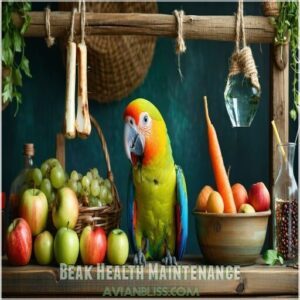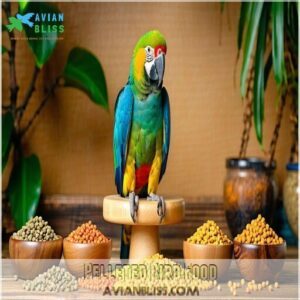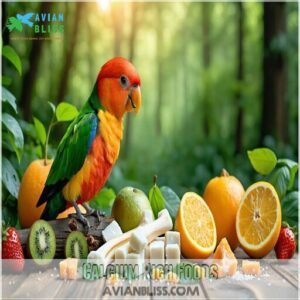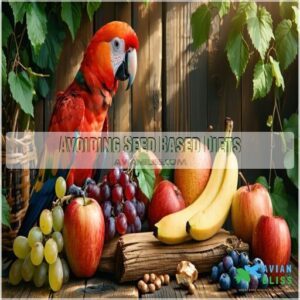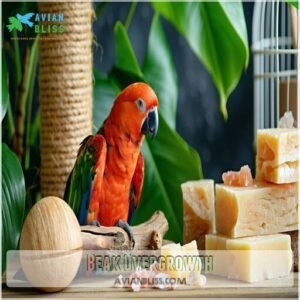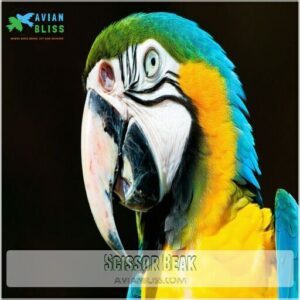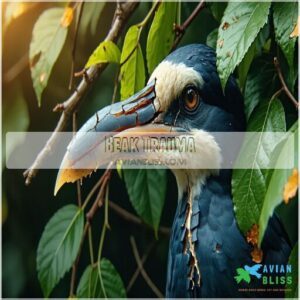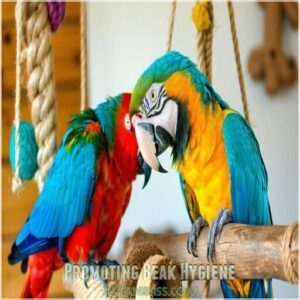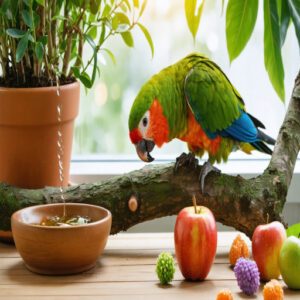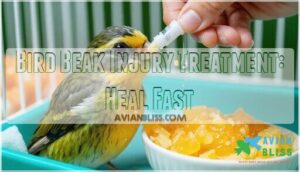This site is supported by our readers. We may earn a commission, at no cost to you, if you purchase through links.
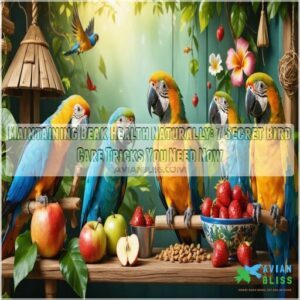 You’ll find maintaining beak health naturally isn’t rocket science – it’s all about creating the right environment.
You’ll find maintaining beak health naturally isn’t rocket science – it’s all about creating the right environment.
Start with textured perches that mimic wild surfaces, giving your bird’s beak a natural workout. Mix up their playground with untreated hardwood perches and rotate engaging chew toys to keep that beak in tip-top shape.
Just like you need a balanced diet, your feathered friend thrives on pelleted food and fresh fruits rather than seeds alone.
Keep an eye on your bird’s beak shape and color during regular check-ups. Wait until you discover how simple cage setups can transform your bird’s beak care routine.
Table Of Contents
- Key Takeaways
- Beak Health Maintenance
- Diet for Beak Health
- Environmental Enrichment
- Beak Problems and Solutions
- Promoting Beak Hygiene
- Frequently Asked Questions (FAQs)
- How do you keep a healthy beak?
- How do you keep a bird’s beak strong?
- How do you keep a cockatiel’s beak healthy?
- How do you keep a budgerigar’s beak healthy?
- How to keep a budgie’s beak healthy?
- Why do budgerigars need a healthy beak?
- How to keep bird beaks healthy?
- How to strengthen a bird’s beak?
- What does an unhealthy beak look like?
- What causes beak overgrowth?
- Conclusion
Key Takeaways
- You’ll keep your bird’s beak healthy by providing a balanced environment with textured perches, cuttlebones, and chew toys that promote natural filing and exercise.
- It’s crucial to feed your bird a calcium-rich diet with fresh fruits, veggies, and pellets to support beak health and prevent issues like overgrowth or cracking.
- You should inspect your bird’s beak regularly to catch potential problems early, checking for signs like cracks, asymmetry, or discoloration, and address them promptly to maintain overall healthy beak.
- By offering a variety of perches, toys, and a nutritious diet, you’re helping your bird maintain a healthy beak, which is essential for eating, grooming, and overall well-being, so keep their surroundings and diet in check to ensure a happy, healthy beak.
Beak Health Maintenance
You’ll find your bird’s beak stays naturally healthy when you provide the right tools like conditioning perches, wooden toys, and cuttlebones.
Regular inspections help you catch potential problems early, ensuring your feathered friend can eat and groom properly, which is crucial for maintaining overall health, and this is where regular inspections play a significant role.
Conditioning Perches
Conditioning perches are your bird’s secret weapon for natural beak maintenance. These specially designed perches feature varying textures that provide gentle abrasion as your feathered friend moves around their cage.
You’ll want to position them strategically where your bird frequently perches. Unlike regular perches, these innovative surfaces help file down beaks naturally, mimicking the varied surfaces birds encounter in the wild.
For further beak care guidance, review these parrot beak care tips. It’s essential for maintaining ideal beak length and shape.
Wooden Perches
You’ll find that wooden perches perfectly mimic your bird’s natural habitat while promoting healthy beak maintenance.
Natural wood benefits extend beyond comfort – these perches provide essential filing surfaces that keep beaks properly trimmed. The use of wooden bird perches is essential for maintaining beak health.
Here’s what makes wooden perches essential for beak health:
- Different wood types offer varying textures for natural beak filing
- Multiple perch sizes encourage diverse foot positioning
- Untreated hardwoods provide safe chewing surfaces for instinctive beak care and overall well-being through natural habitat mimicry.
Chew Toys
You’ll love using rope toys, chew blocks, and wooden chews to keep your bird’s beak healthy.
Rotate toys regularly for varied beak exercise, promoting natural beak care and maintenance, which is essential for overall beak health.
Making these bird toys a great addition to your beak maintenance routine.
Cuttlebones
You’re giving your bird chew toys, now add cuttlebones, a natural calcium source, to support beak filing and growth.
This addition promotes healthy beak maintenance and overall bird nutrition, a key part of natural beak care and beak health.
Regular Inspections
You perform regular beak inspections, checking for signs of problems.
- Beak shape
- Color
- Texture
- Alignment, to maintain your bird’s beak health, detecting issues early, like overgrowth or cracks, for natural beak cleaning and to prevent beak problems.
To ensure the best care, these inspections are crucial for beak health.
Diet for Beak Health
You play an essential role in maintaining your bird’s beak health through a well-balanced diet.
By choosing the right foods, such as pelleted bird food, fresh fruits, and calcium-rich foods, you can help prevent beak problems and support overall health.
Pelleted Bird Food
You’re looking for a balanced bird diet.
Pelleted bird food offers complete nutrition, including vitamins and minerals, supporting beak health with proper pellet nutrition and a balanced diet, making it a great choice for your bird’s overall health and beak nutrition.
Understanding bird food pellets is essential for providing the best nutrition for your bird.
Fresh Fruits and Vegetables
You can offer several fresh fruits and vegetables for natural beak cleaning, including:
- Carrots
- Apples
- Broccoli
- Sweet potatoes, providing nutritious options and vitamin benefits for beak health and hydration source.
Calcium Rich Foods
You prioritize calcium sources, like cuttlebones and mineral blocks, to support beak health, preventing calcium deficiency and promoting natural beak cleaning through a nutrient-dense beak diet.
This diet is essential for your bird’s overall well-being and healthy beak development, an important aspect of bird beak health.
Avoiding Seed Based Diets
You avoid seed-based diets, opting for nutrient balance with pellet benefits and calcium sources.
Fresh fruits are great alternatives, supporting beak health with natural supplements, for a healthy beak diet and overall bird health.
They provide nutrient balance with the benefits mentioned.
Balanced Nutrition
You maintain nutrient balance by providing food variety, including calcium sources and vitamin supplements.
Healthy treats support beak health, making natural beak supplements unnecessary.
A well-planned diet with vitamins and calcium promotes strong beak health, overall nutrition, and a healthy beak.
Environmental Enrichment
You can help maintain your bird’s beak health by providing environmental enrichment, which includes offering a variety of perches and toys to keep them engaged.
By rotating chew toys and setting up a stimulating cage environment, you’re encouraging natural beak exercise and promoting overall health.
Variety of Perches
You’ll need a variety of perches, including:
- Rope toys
- Wooden ladders
- Swing perches
- Conditioning perches
- Textured perches, to keep your bird’s beak healthy through beak filing on different perch materials, like birdsafe wood perches.
The variety of perches is crucial for your bird’s health, as it allows for beak filing on different materials.
Chew Toys Rotation
Rotate chew toys regularly to keep your bird engaged and exercised.
Toy variety is key to beak health, so establish a rotation schedule with birdsafe wood perches and other safe options to promote natural beak cleaning methods and prevent boredom, supporting overall beak exercise and health.
Providing appropriate bird chew options is essential for maintaining beak health and preventing behavioral problems.
Cage Setup and Accessories
You set up your bird’s cage with a variety of perches, like conditioning and wooden ones, and toys to keep them engaged.
Consider the cage layout, bar spacing, and add nesting boxes for a stimulating environment that promotes beak health and exercise, with textured perches and chew toys nearby.
Providing essential budgie cage supplies creates a comfortable and enriching habitat.
Natural Wood Perches
You’re setting up a great cage with accessories, now consider natural wood perches.
They offer:
- Wood Perch Benefits
- Natural Abrasion
- Wood Texture
- Beak Filing
for your bird’s beak health, providing a textured surface for filing and exercise.
Unshelled Whole Nuts
You’ll love unshelled whole nuts for beak exercise, offering a crunchy texture and nutrient content that supports natural beak health.
Making beak trimming naturally easier, and promoting healthy beak tips through shell removal and nut variety, is a great addition to your beak health maintenance routine, supporting natural beak health and beak exercise.
Beak Problems and Solutions
You’ll encounter various beak problems, such as overgrowth or cracking, if you don’t provide your bird with proper care and nutrition.
By understanding these issues, you can take steps to prevent or solve them, ensuring your bird’s beak remains healthy and strong.
Beak Overgrowth
You can prevent beak overgrowth by:
- Providing calcium-rich foods
- Offering wooden perches
- Rotating chew toys
- Monitoring beak alignment, addressing nutrient deficiencies and growth issues with beak trimming for safety and natural beak filing to prevent beak health problems.
Understanding beak abnormality causes is important for effective prevention and treatment.
Cracked or Flaking Beaks
You’ll notice cracked or flaky beaks, often due to vitamin deficiencies, can cause beak pain.
Beak repair may be needed, and it’s essential to maintain beak conditioning to address these issues.
Consider beak supplements to address flaky causes and beak fractures, promoting overall beak health.
Scissor Beak
You’ll encounter Scissor Beak, a condition where the beak crosses over, causing beak malocclusion.
This requires beak surgery or prosthetics, a form of avian orthodontics.
Regular beak trimming can help, but severe cases need professional attention to prevent beak health issues and maintain proper beak alignment.
Beak Trauma
You manage beak trauma by addressing causes like fractures.
- Beak fractures
- Trauma causes
- Beak repair
- Emergency care
- Avian first aid
to treat beak injury, repair beak damage, and provide beak injury treatment.
Beak Trimming
Beak trimming is sometimes necessary to address overgrowth or abnormalities. This procedure should only be performed by an avian veterinarian, guaranteeing it’s done correctly and safely.
Beak trimming is controversial, with some countries banning it due to the potential for acute stress and pain. Here’s a summary of do’s and don’ts for beak trimming:
| Do’s | Don’ts |
|---|---|
| Consult an avian vet | Attempt DIY trimming |
| Address overgrowth | Ignore abnormalities |
| Make sure safety | Cause unnecessary pain |
Trimming tools and techniques vary, but the goal is a smooth, well-shaped beak.
Promoting Beak Hygiene
Play a vital role in promoting your bird’s beak hygiene by providing the right tools and environment.
By using textured perches, natural branches, and safe chewable toys, you can help keep your bird’s beak clean and healthy.
Textured Perches
You can promote beak health with textured perches, which provide natural abrasion for beak filing.
Rough surfaces help extract debris, supporting beak exercise and grinding, making them a great tool for beak maintenance and overall beak health.
Natural Branches
You’ll love using natural branches for beak care.
Here are 5 benefits:
- Forest enrichment
- Wild foraging
- Bark texture
- Natural debris extraction
- Beak grinding, all supporting natural beak cleaning habits and beak health.
Using natural branches also promotes beak health importance and overall well-being in birds, which is crucial for their natural development.
Safe Chewable Toys
You’ll want toys for beak exercise, like chewable toys made from safe materials.
Rotate them regularly to keep your bird engaged and maintain bird safety.
Wooden perches and textured perches also help, providing a healthy outlet for chewing and beak maintenance, essential for overall beak health and hygiene.
Beak Wiping
Beak wiping is a natural behavior that keeps feathers clean and healthy. It’s like a bird’s version of washing your face in the morning.
Here are three quick tips:
- Use a damp cloth or cotton swab for gentle wiping, especially around the eyes and beak corners.
- Encourage natural wiping by offering textured perches and branches, mimicking wild environments.
- Regular wiping removes food, dirt, and oils, reducing infection risk and promoting beak health.
Beak hygiene just got a whole lot easier with these simple quick tips and by understanding the importance of natural behavior.
Fresh Water and Cleaning
Setting out fresh, clean drinking water daily keeps your bird’s beak naturally clean and healthy.
Your feathered friend will instinctively rinse their beak after meals, helping remove stuck food particles and debris.
For effective beak hygiene practices, change the water twice daily and make sure the bowl is deep enough for comfortable beak dipping.
This simple cleaning method supports overall avian beak health.
Frequently Asked Questions (FAQs)
How do you keep a healthy beak?
Give your bird cuttlebones, textured perches, and chew toys for natural filing. You’ll need a balanced diet with fresh fruits and pellets, plus regular vet checks to spot issues early.
How do you keep a bird’s beak strong?
Provide cuttlebones, wooden perches, and tough nuts to strengthen your bird’s beak naturally. Include varied textures and toys for exercise, while maintaining a calcium-rich diet with fresh fruits and vegetables.
How do you keep a cockatiel’s beak healthy?
Looking to keep your cockatiel’s beak in top shape?
Offer wooden perches, cuttlebones, and safe chew toys.
Feed a balanced diet with pellets and fresh foods.
Regular vet check-ups catch problems early.
How do you keep a budgerigar’s beak healthy?
You’ll keep your budgie’s beak healthy with textured perches, cuttlebones, and wooden toys.
Offer fresh fruits and veggies daily, monitor for abnormalities, and schedule regular vet checkups for professional trimming when needed.
How to keep a budgie’s beak healthy?
Offer wooden perches and cuttlebones for natural filing.
You’ll need to provide chew toys and make sure a calcium-rich diet.
Regular inspections help spot overgrowth early.
Clean water encourages natural beak rinsing, and it is crucial for regular inspections to be done to maintain the health of the birds.
Why do budgerigars need a healthy beak?
Your budgie’s beak is essential for eating, grooming, exploring toys, climbing, nest building, and communicating.
It helps them crack seeds, preen feathers, defend territory, and express emotions through beak grinding when content, which is a crucial aspect of their behavior and overall well-being, including emotions.
How to keep bird beaks healthy?
90% of birds with healthy beaks live longer lives.
Provide natural wood perches, cuttlebones, and chew toys.
Provide a calcium-rich diet with fresh fruits and vegetables.
Clean water helps birds rinse their beaks naturally.
How to strengthen a bird’s beak?
Provide your bird with cuttlebones, wooden perches, and toys that encourage chewing.
You’ll strengthen their beak naturally when they chew these items.
A calcium-rich diet with nuts and pellets also helps.
What does an unhealthy beak look like?
Is your bird’s beak a shadow of its former glory? Look for cracks, asymmetry, overgrowth, peeling layers, discoloration, or unusual texture. You’ll also notice difficulty eating or abnormal behavior.
What causes beak overgrowth?
Beak overgrowth happens when your bird lacks proper filing opportunities.
It’s caused by inadequate hard surfaces for chewing, nutritional deficiencies, or genetic predispositions.
Captive environments often don’t provide enough natural abrasion sources, which can lead to beak overgrowth issues.
Conclusion
Like a well-oiled machine, your bird’s beak will thrive with proper care.
You’re now equipped to tackle maintaining beak health naturally by creating a balanced environment.
Remember, maintaining beak health naturally is key to your bird’s overall well-being, so keep their diet and surroundings in check to maintain a happy, healthy beak.
- https://www.manukahoneyusa.com/blog/how-to-maintain-your-birds-beak-health.html
- https://www.poodlesandparrots.com/blog/posts/bird-beak-health
- https://budgiefly.com/budgies-beak-care-guide-tips-tricks-for-healthy-beak-maintenance/
- https://kniselys.com/blog/64135/parrot-beak-care-101
- https://www.theanimaldoctors.org/chirp-up-mastering-the-art-of-beak-health-in-birds/

